Business Management Skills: Leadership and Motivation in Project
VerifiedAdded on 2024/06/27
|12
|2066
|161
Report
AI Summary
This assignment provides a comprehensive analysis of effective business management skills, emphasizing their crucial role in organizational administration. It explores the significance of communication in managing diverse departments and highlights essential considerations for Warwick District Council in promoting effective cultural management, diversity, and workplace practices. Furthermore, the assignment outlines best management practices in motivation, decision-making, and problem-solving, recommending specific models for implementation within the District Council's new Leamington Spa office. This report underscores the importance of leadership and motivation in achieving organizational goals and fostering a productive work environment. Desklib is your go-to platform for accessing a wide array of study resources, including past papers and solved assignments, designed to support students in their academic endeavors.
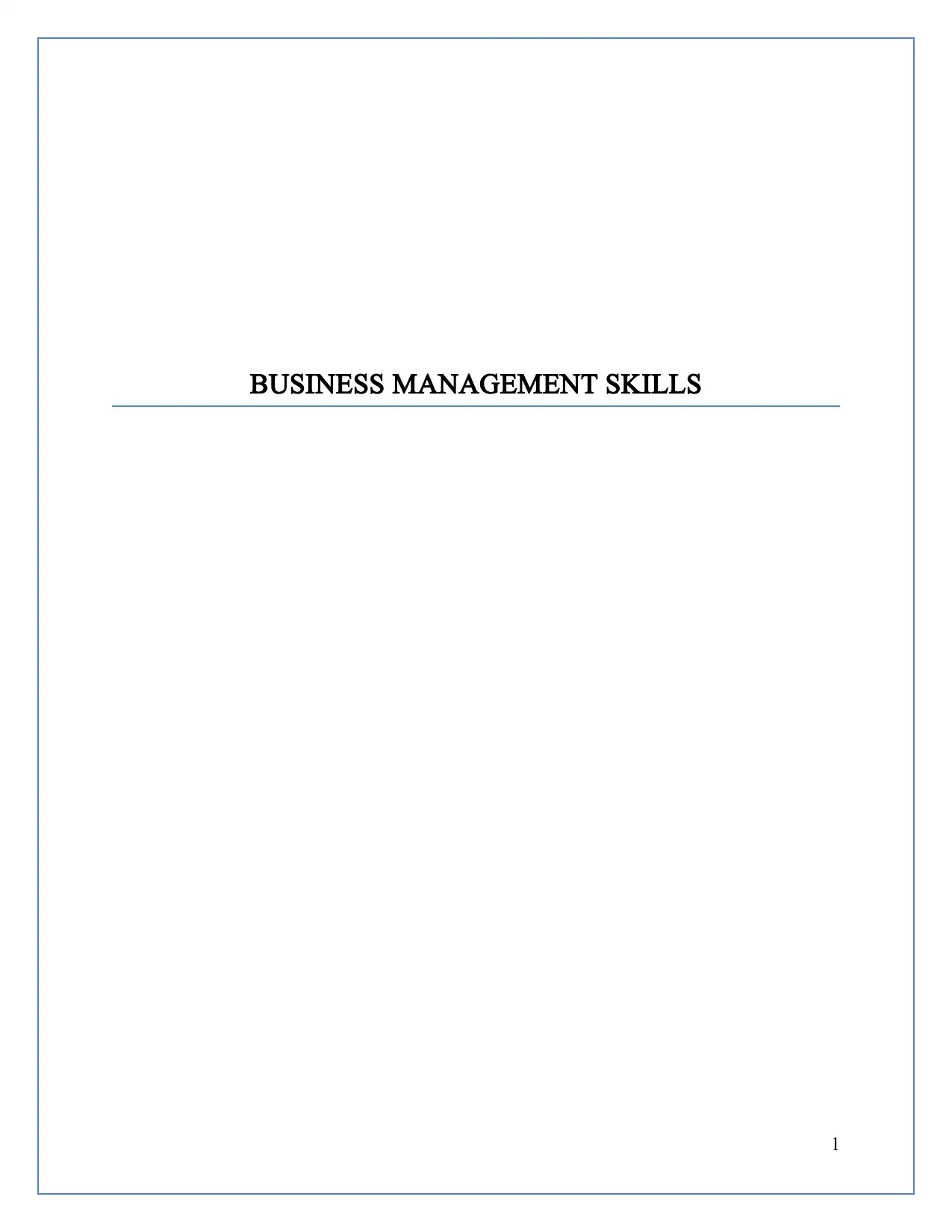
BUSINESS MANAGEMENT SKILLS
1
1
Paraphrase This Document
Need a fresh take? Get an instant paraphrase of this document with our AI Paraphraser
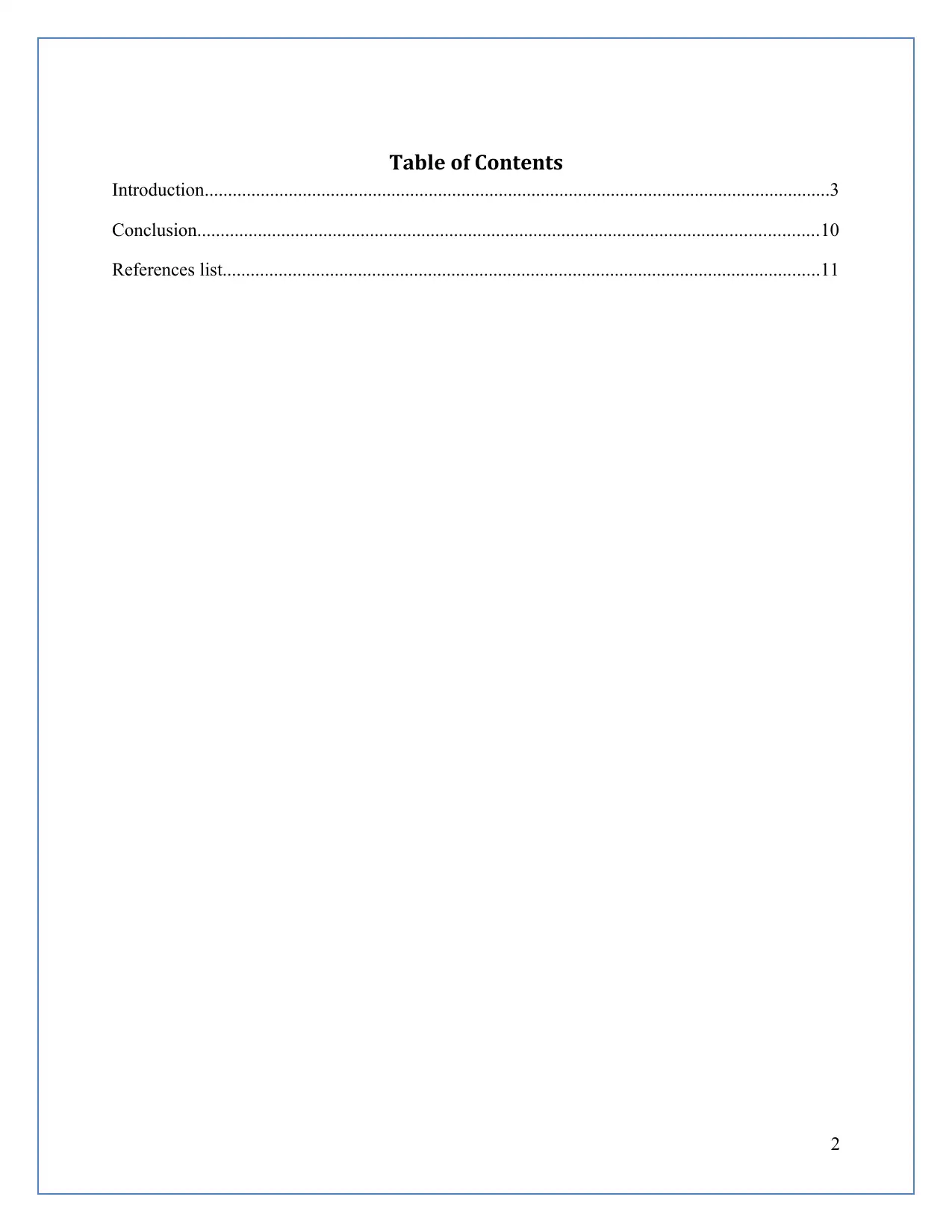
Table of Contents
Introduction......................................................................................................................................3
Conclusion.....................................................................................................................................10
References list................................................................................................................................11
2
Introduction......................................................................................................................................3
Conclusion.....................................................................................................................................10
References list................................................................................................................................11
2
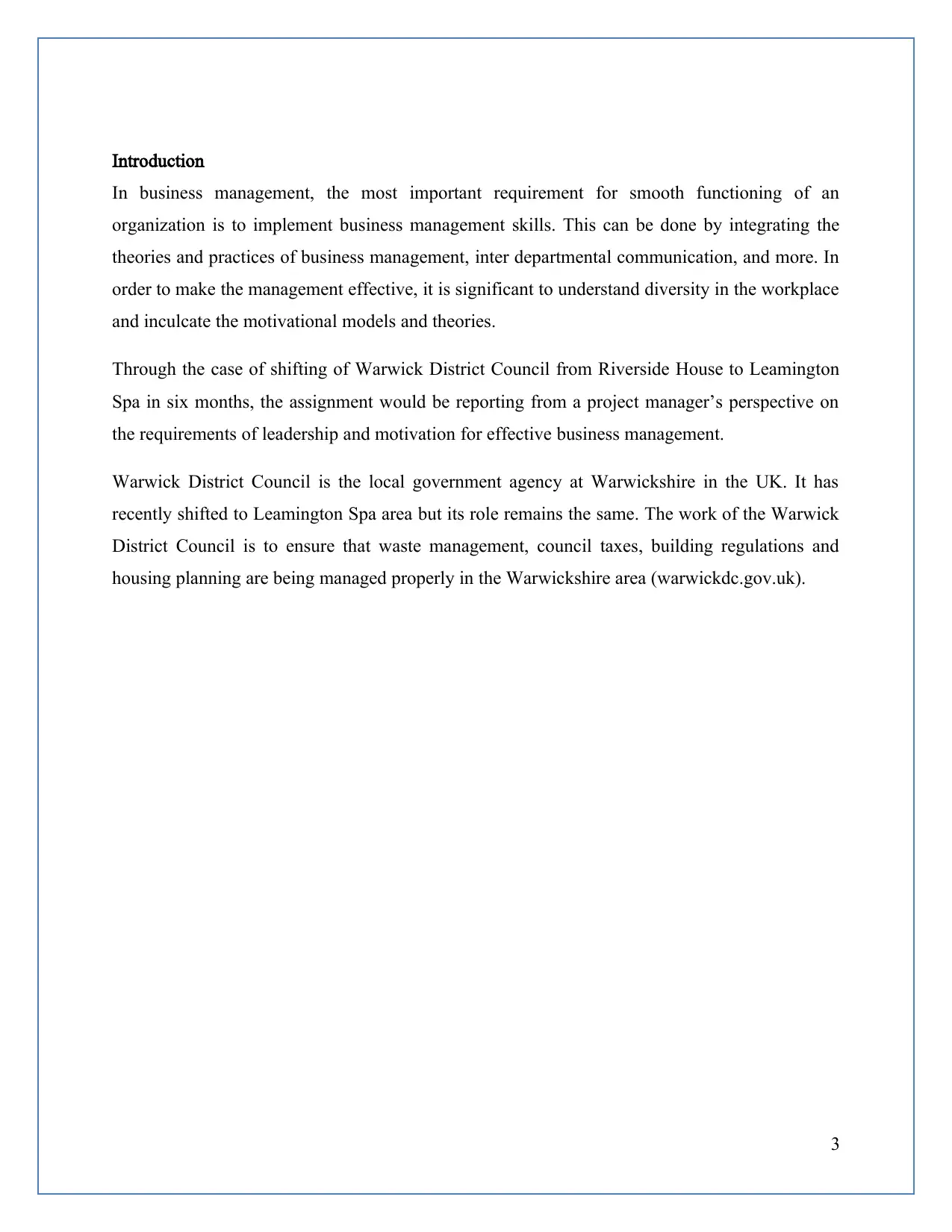
Introduction
In business management, the most important requirement for smooth functioning of an
organization is to implement business management skills. This can be done by integrating the
theories and practices of business management, inter departmental communication, and more. In
order to make the management effective, it is significant to understand diversity in the workplace
and inculcate the motivational models and theories.
Through the case of shifting of Warwick District Council from Riverside House to Leamington
Spa in six months, the assignment would be reporting from a project manager’s perspective on
the requirements of leadership and motivation for effective business management.
Warwick District Council is the local government agency at Warwickshire in the UK. It has
recently shifted to Leamington Spa area but its role remains the same. The work of the Warwick
District Council is to ensure that waste management, council taxes, building regulations and
housing planning are being managed properly in the Warwickshire area (warwickdc.gov.uk).
3
In business management, the most important requirement for smooth functioning of an
organization is to implement business management skills. This can be done by integrating the
theories and practices of business management, inter departmental communication, and more. In
order to make the management effective, it is significant to understand diversity in the workplace
and inculcate the motivational models and theories.
Through the case of shifting of Warwick District Council from Riverside House to Leamington
Spa in six months, the assignment would be reporting from a project manager’s perspective on
the requirements of leadership and motivation for effective business management.
Warwick District Council is the local government agency at Warwickshire in the UK. It has
recently shifted to Leamington Spa area but its role remains the same. The work of the Warwick
District Council is to ensure that waste management, council taxes, building regulations and
housing planning are being managed properly in the Warwickshire area (warwickdc.gov.uk).
3
⊘ This is a preview!⊘
Do you want full access?
Subscribe today to unlock all pages.

Trusted by 1+ million students worldwide
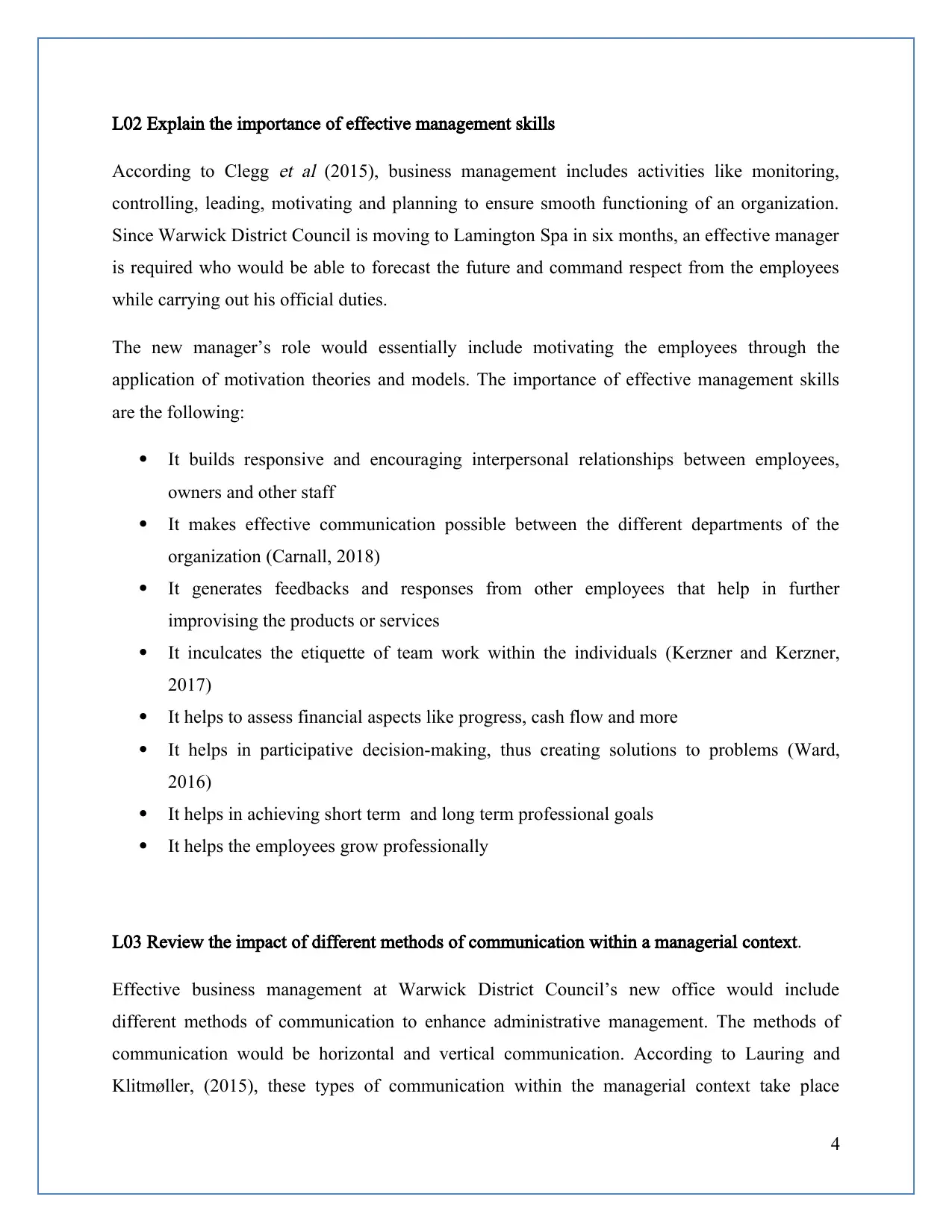
L02 Explain the importance of effective management skills
According to Clegg
et al (2015), business management includes activities like monitoring,
controlling, leading, motivating and planning to ensure smooth functioning of an organization.
Since Warwick District Council is moving to Lamington Spa in six months, an effective manager
is required who would be able to forecast the future and command respect from the employees
while carrying out his official duties.
The new manager’s role would essentially include motivating the employees through the
application of motivation theories and models. The importance of effective management skills
are the following:
It builds responsive and encouraging interpersonal relationships between employees,
owners and other staff
It makes effective communication possible between the different departments of the
organization (Carnall, 2018)
It generates feedbacks and responses from other employees that help in further
improvising the products or services
It inculcates the etiquette of team work within the individuals (Kerzner and Kerzner,
2017)
It helps to assess financial aspects like progress, cash flow and more
It helps in participative decision-making, thus creating solutions to problems (Ward,
2016)
It helps in achieving short term and long term professional goals
It helps the employees grow professionally
L03 Review the impact of different methods of communication within a managerial context.
Effective business management at Warwick District Council’s new office would include
different methods of communication to enhance administrative management. The methods of
communication would be horizontal and vertical communication. According to Lauring and
Klitmøller, (2015), these types of communication within the managerial context take place
4
According to Clegg
et al (2015), business management includes activities like monitoring,
controlling, leading, motivating and planning to ensure smooth functioning of an organization.
Since Warwick District Council is moving to Lamington Spa in six months, an effective manager
is required who would be able to forecast the future and command respect from the employees
while carrying out his official duties.
The new manager’s role would essentially include motivating the employees through the
application of motivation theories and models. The importance of effective management skills
are the following:
It builds responsive and encouraging interpersonal relationships between employees,
owners and other staff
It makes effective communication possible between the different departments of the
organization (Carnall, 2018)
It generates feedbacks and responses from other employees that help in further
improvising the products or services
It inculcates the etiquette of team work within the individuals (Kerzner and Kerzner,
2017)
It helps to assess financial aspects like progress, cash flow and more
It helps in participative decision-making, thus creating solutions to problems (Ward,
2016)
It helps in achieving short term and long term professional goals
It helps the employees grow professionally
L03 Review the impact of different methods of communication within a managerial context.
Effective business management at Warwick District Council’s new office would include
different methods of communication to enhance administrative management. The methods of
communication would be horizontal and vertical communication. According to Lauring and
Klitmøller, (2015), these types of communication within the managerial context take place
4
Paraphrase This Document
Need a fresh take? Get an instant paraphrase of this document with our AI Paraphraser
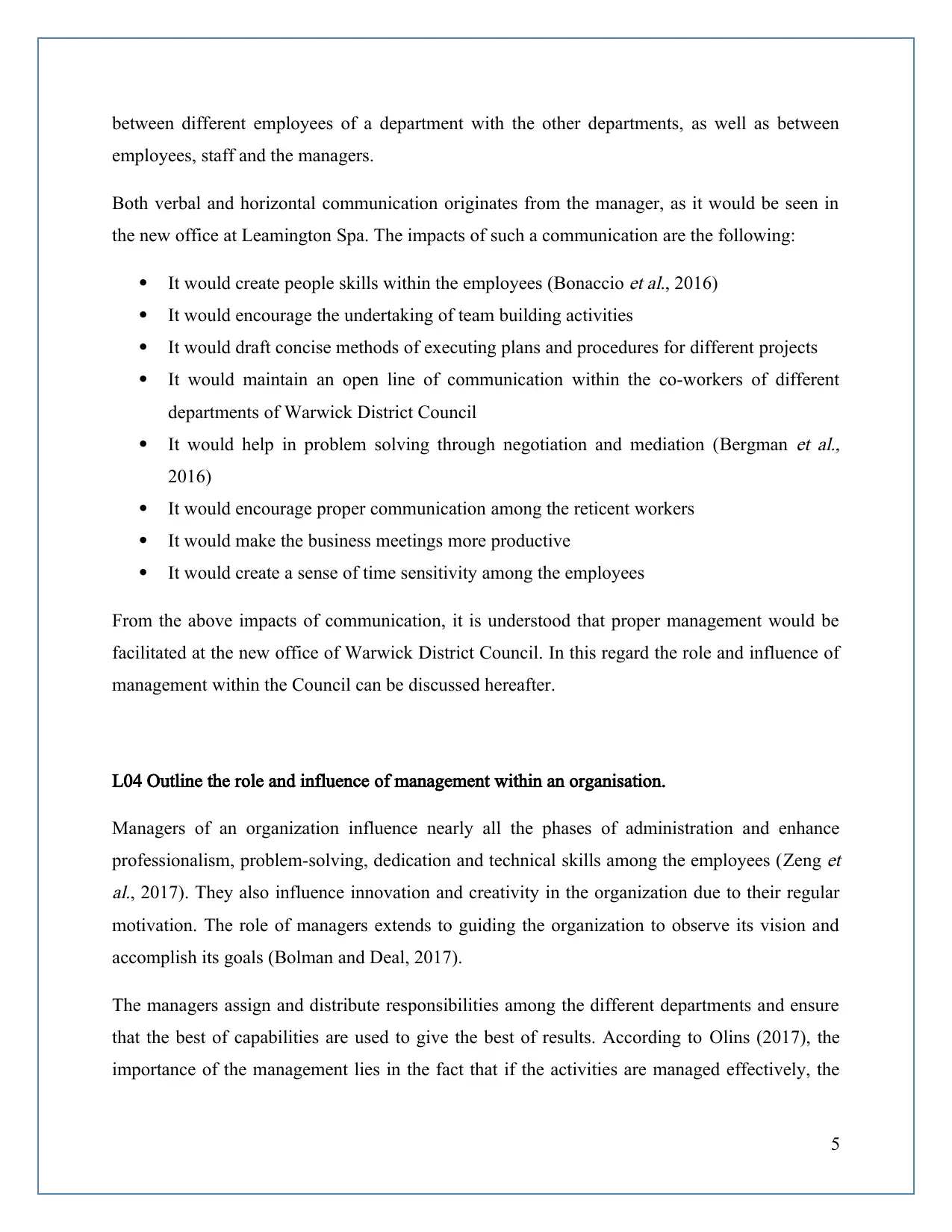
between different employees of a department with the other departments, as well as between
employees, staff and the managers.
Both verbal and horizontal communication originates from the manager, as it would be seen in
the new office at Leamington Spa. The impacts of such a communication are the following:
It would create people skills within the employees (Bonaccio
et al., 2016)
It would encourage the undertaking of team building activities
It would draft concise methods of executing plans and procedures for different projects
It would maintain an open line of communication within the co-workers of different
departments of Warwick District Council
It would help in problem solving through negotiation and mediation (Bergman
et al.,
2016)
It would encourage proper communication among the reticent workers
It would make the business meetings more productive
It would create a sense of time sensitivity among the employees
From the above impacts of communication, it is understood that proper management would be
facilitated at the new office of Warwick District Council. In this regard the role and influence of
management within the Council can be discussed hereafter.
L04 Outline the role and influence of management within an organisation.
Managers of an organization influence nearly all the phases of administration and enhance
professionalism, problem-solving, dedication and technical skills among the employees (Zeng
et
al., 2017). They also influence innovation and creativity in the organization due to their regular
motivation. The role of managers extends to guiding the organization to observe its vision and
accomplish its goals (Bolman and Deal, 2017).
The managers assign and distribute responsibilities among the different departments and ensure
that the best of capabilities are used to give the best of results. According to Olins (2017), the
importance of the management lies in the fact that if the activities are managed effectively, the
5
employees, staff and the managers.
Both verbal and horizontal communication originates from the manager, as it would be seen in
the new office at Leamington Spa. The impacts of such a communication are the following:
It would create people skills within the employees (Bonaccio
et al., 2016)
It would encourage the undertaking of team building activities
It would draft concise methods of executing plans and procedures for different projects
It would maintain an open line of communication within the co-workers of different
departments of Warwick District Council
It would help in problem solving through negotiation and mediation (Bergman
et al.,
2016)
It would encourage proper communication among the reticent workers
It would make the business meetings more productive
It would create a sense of time sensitivity among the employees
From the above impacts of communication, it is understood that proper management would be
facilitated at the new office of Warwick District Council. In this regard the role and influence of
management within the Council can be discussed hereafter.
L04 Outline the role and influence of management within an organisation.
Managers of an organization influence nearly all the phases of administration and enhance
professionalism, problem-solving, dedication and technical skills among the employees (Zeng
et
al., 2017). They also influence innovation and creativity in the organization due to their regular
motivation. The role of managers extends to guiding the organization to observe its vision and
accomplish its goals (Bolman and Deal, 2017).
The managers assign and distribute responsibilities among the different departments and ensure
that the best of capabilities are used to give the best of results. According to Olins (2017), the
importance of the management lies in the fact that if the activities are managed effectively, the
5

productivity of all departments automatically enhances. As a result, the individual employees
also improve in their professionalism.
L05 Evaluate the importance of diversity in terms of people, cultures, business and management
issues in an organisation.
One of the most important factors of bringing effective management at the Council, managing
diversity in terms of people and culture is a prerequisite. Since the District Council is made of
workers from different strata of society and those speaking different diction and languages, it is
important each of them is given the freedom to work peacefully and co exist productively with
their colleagues. Workplace diversity entails having employees from different cultural
backgrounds, different age groups, gender, caste and race (Barak, 2016). Organizations can
enhance diversity of people by recruiting from all age groups, genders and nationalities and
choosing only on the basis of merit.
The importance of managing diversity in terms of people, culture and business management is
that it brings the following:
Combined talent and skills of different groups of people
Enhanced ideas for innovation and creativity
Diverse language skills open doors to more business opportunities (Mehra and Sharma,
2018)
Improved pool of talent within the organization
Record growths in fulfilling organizational goals
L06 Explore management theories on motivation, decision making and problem solving.
Motivation of employees is one of the most vital roles of an effective manager (Wheelen
et al.,
2017). The new office of the District Council must therefore apply the management theories of
motivation, decision making and problem solving to enhance the professional development of
their employees.
6
also improve in their professionalism.
L05 Evaluate the importance of diversity in terms of people, cultures, business and management
issues in an organisation.
One of the most important factors of bringing effective management at the Council, managing
diversity in terms of people and culture is a prerequisite. Since the District Council is made of
workers from different strata of society and those speaking different diction and languages, it is
important each of them is given the freedom to work peacefully and co exist productively with
their colleagues. Workplace diversity entails having employees from different cultural
backgrounds, different age groups, gender, caste and race (Barak, 2016). Organizations can
enhance diversity of people by recruiting from all age groups, genders and nationalities and
choosing only on the basis of merit.
The importance of managing diversity in terms of people, culture and business management is
that it brings the following:
Combined talent and skills of different groups of people
Enhanced ideas for innovation and creativity
Diverse language skills open doors to more business opportunities (Mehra and Sharma,
2018)
Improved pool of talent within the organization
Record growths in fulfilling organizational goals
L06 Explore management theories on motivation, decision making and problem solving.
Motivation of employees is one of the most vital roles of an effective manager (Wheelen
et al.,
2017). The new office of the District Council must therefore apply the management theories of
motivation, decision making and problem solving to enhance the professional development of
their employees.
6
⊘ This is a preview!⊘
Do you want full access?
Subscribe today to unlock all pages.

Trusted by 1+ million students worldwide
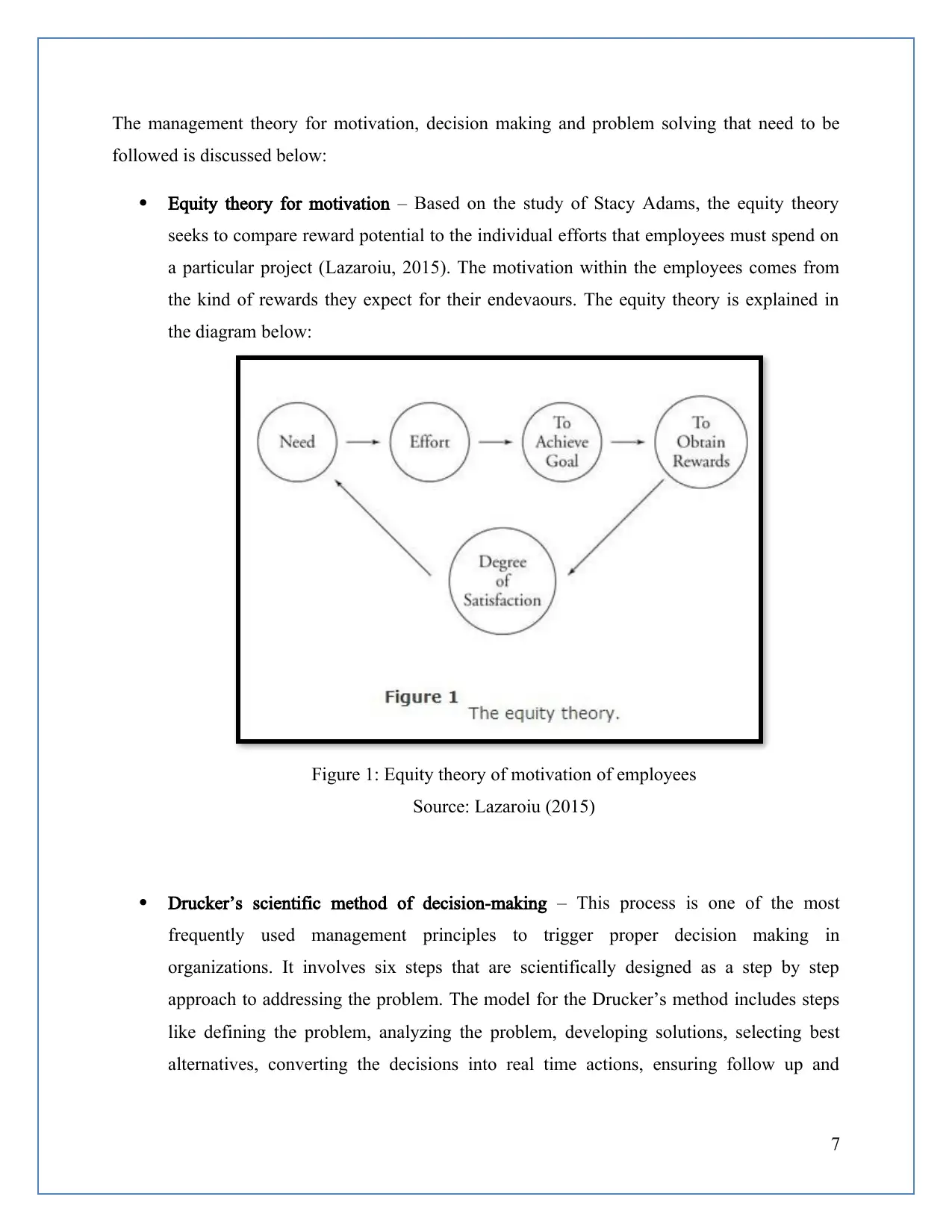
The management theory for motivation, decision making and problem solving that need to be
followed is discussed below:
Equity theory for motivation – Based on the study of Stacy Adams, the equity theory
seeks to compare reward potential to the individual efforts that employees must spend on
a particular project (Lazaroiu, 2015). The motivation within the employees comes from
the kind of rewards they expect for their endevaours. The equity theory is explained in
the diagram below:
Figure 1: Equity theory of motivation of employees
Source: Lazaroiu (2015)
Drucker’s scientific method of decision-making – This process is one of the most
frequently used management principles to trigger proper decision making in
organizations. It involves six steps that are scientifically designed as a step by step
approach to addressing the problem. The model for the Drucker’s method includes steps
like defining the problem, analyzing the problem, developing solutions, selecting best
alternatives, converting the decisions into real time actions, ensuring follow up and
7
followed is discussed below:
Equity theory for motivation – Based on the study of Stacy Adams, the equity theory
seeks to compare reward potential to the individual efforts that employees must spend on
a particular project (Lazaroiu, 2015). The motivation within the employees comes from
the kind of rewards they expect for their endevaours. The equity theory is explained in
the diagram below:
Figure 1: Equity theory of motivation of employees
Source: Lazaroiu (2015)
Drucker’s scientific method of decision-making – This process is one of the most
frequently used management principles to trigger proper decision making in
organizations. It involves six steps that are scientifically designed as a step by step
approach to addressing the problem. The model for the Drucker’s method includes steps
like defining the problem, analyzing the problem, developing solutions, selecting best
alternatives, converting the decisions into real time actions, ensuring follow up and
7
Paraphrase This Document
Need a fresh take? Get an instant paraphrase of this document with our AI Paraphraser
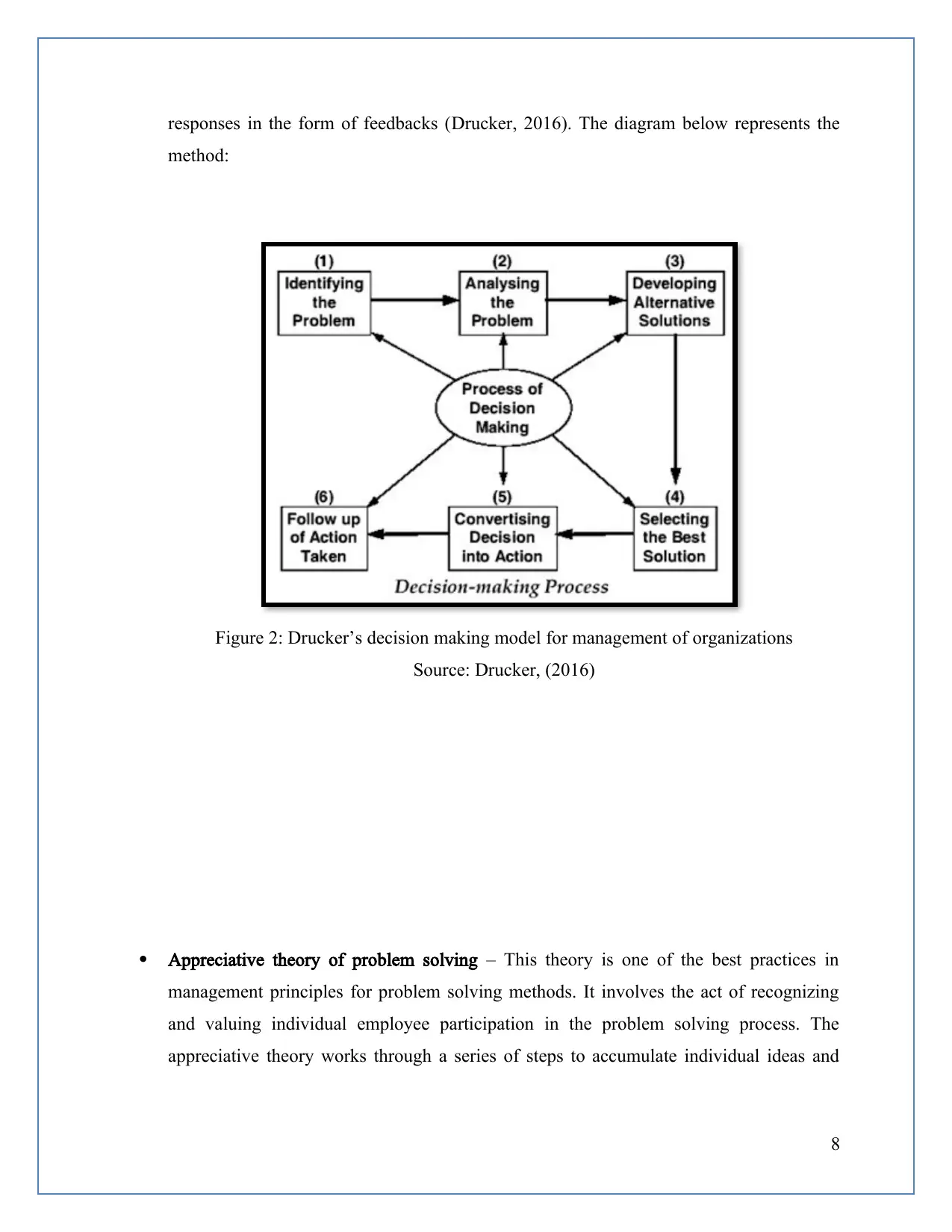
responses in the form of feedbacks (Drucker, 2016). The diagram below represents the
method:
Figure 2: Drucker’s decision making model for management of organizations
Source: Drucker, (2016)
Appreciative theory of problem solving – This theory is one of the best practices in
management principles for problem solving methods. It involves the act of recognizing
and valuing individual employee participation in the problem solving process. The
appreciative theory works through a series of steps to accumulate individual ideas and
8
method:
Figure 2: Drucker’s decision making model for management of organizations
Source: Drucker, (2016)
Appreciative theory of problem solving – This theory is one of the best practices in
management principles for problem solving methods. It involves the act of recognizing
and valuing individual employee participation in the problem solving process. The
appreciative theory works through a series of steps to accumulate individual ideas and
8
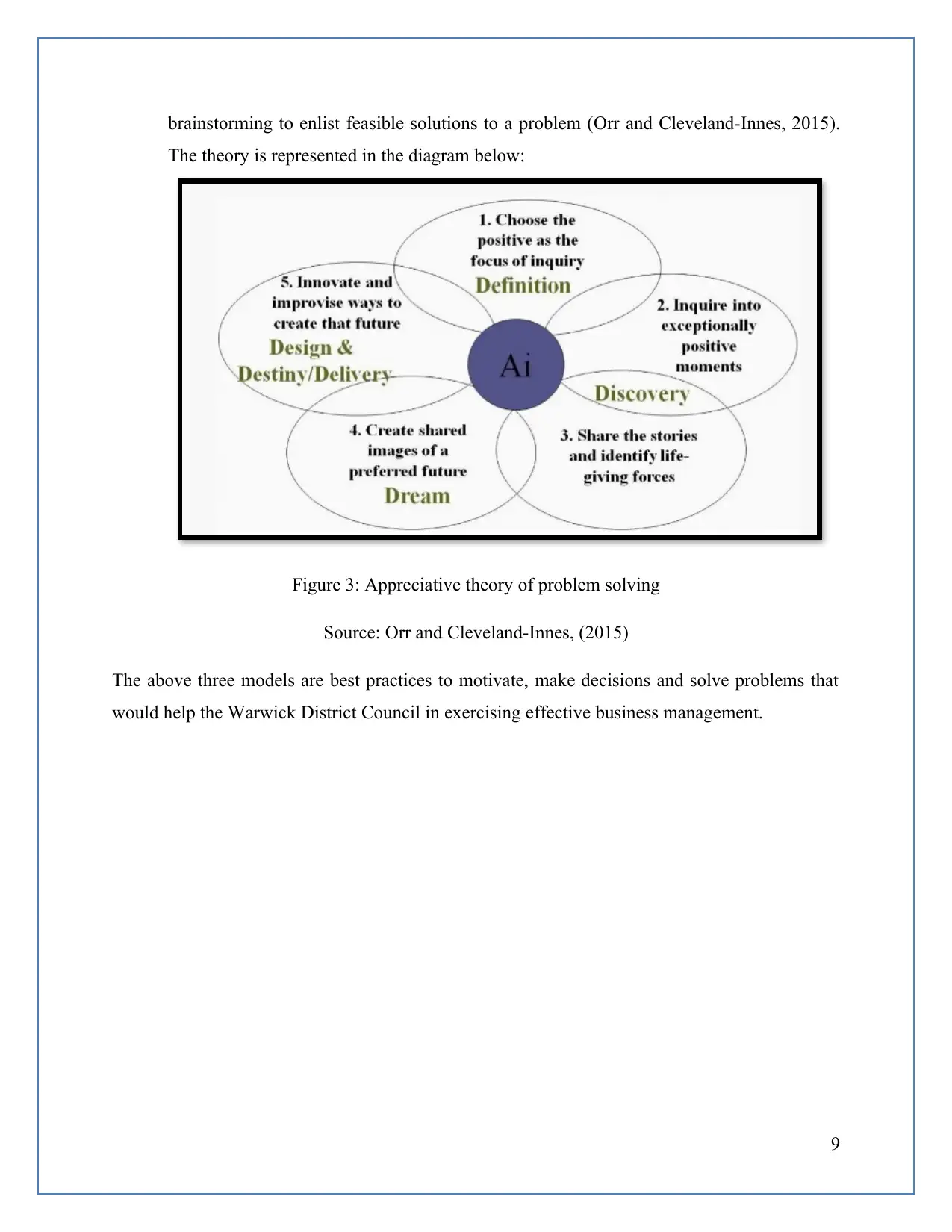
brainstorming to enlist feasible solutions to a problem (Orr and Cleveland-Innes, 2015).
The theory is represented in the diagram below:
Figure 3: Appreciative theory of problem solving
Source: Orr and Cleveland-Innes, (2015)
The above three models are best practices to motivate, make decisions and solve problems that
would help the Warwick District Council in exercising effective business management.
9
The theory is represented in the diagram below:
Figure 3: Appreciative theory of problem solving
Source: Orr and Cleveland-Innes, (2015)
The above three models are best practices to motivate, make decisions and solve problems that
would help the Warwick District Council in exercising effective business management.
9
⊘ This is a preview!⊘
Do you want full access?
Subscribe today to unlock all pages.

Trusted by 1+ million students worldwide
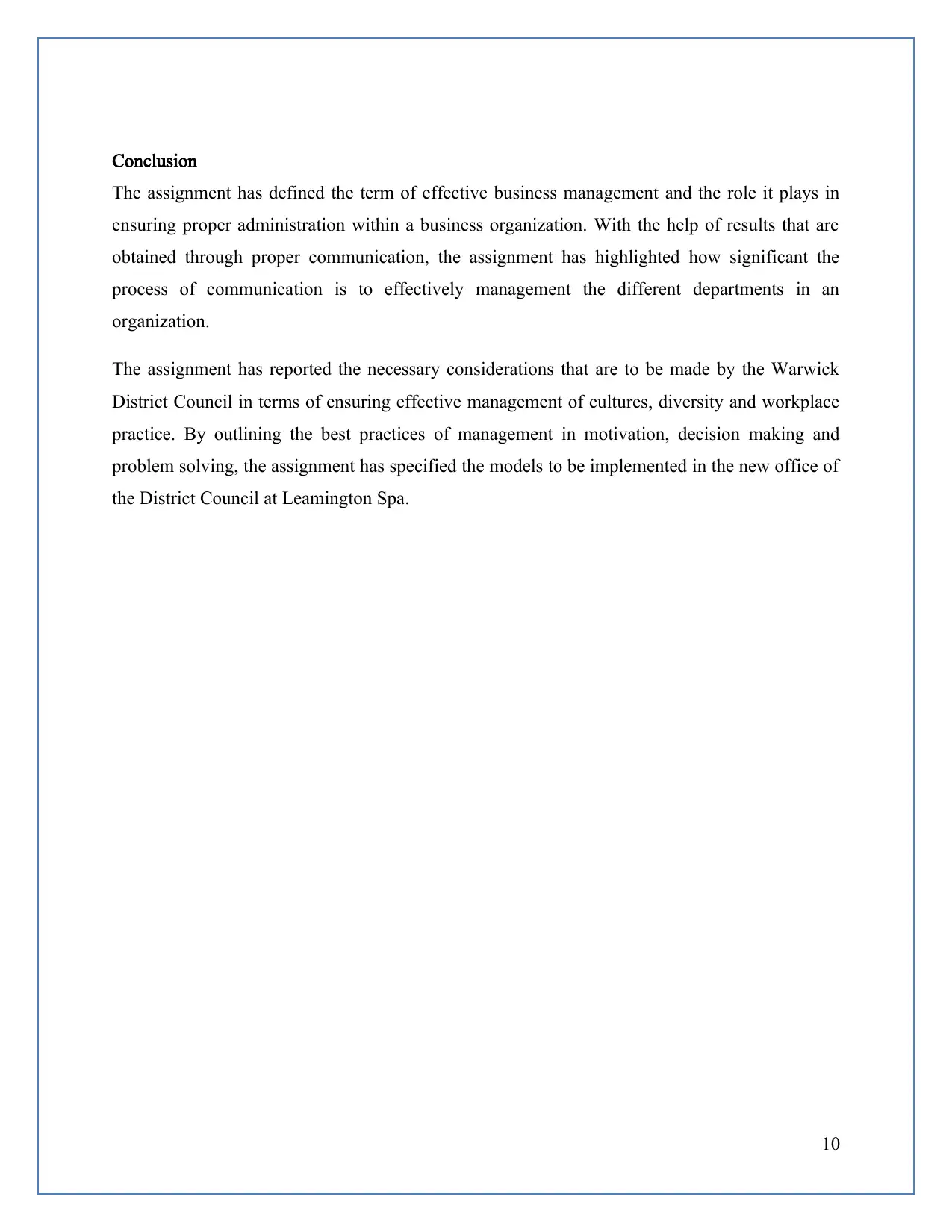
Conclusion
The assignment has defined the term of effective business management and the role it plays in
ensuring proper administration within a business organization. With the help of results that are
obtained through proper communication, the assignment has highlighted how significant the
process of communication is to effectively management the different departments in an
organization.
The assignment has reported the necessary considerations that are to be made by the Warwick
District Council in terms of ensuring effective management of cultures, diversity and workplace
practice. By outlining the best practices of management in motivation, decision making and
problem solving, the assignment has specified the models to be implemented in the new office of
the District Council at Leamington Spa.
10
The assignment has defined the term of effective business management and the role it plays in
ensuring proper administration within a business organization. With the help of results that are
obtained through proper communication, the assignment has highlighted how significant the
process of communication is to effectively management the different departments in an
organization.
The assignment has reported the necessary considerations that are to be made by the Warwick
District Council in terms of ensuring effective management of cultures, diversity and workplace
practice. By outlining the best practices of management in motivation, decision making and
problem solving, the assignment has specified the models to be implemented in the new office of
the District Council at Leamington Spa.
10
Paraphrase This Document
Need a fresh take? Get an instant paraphrase of this document with our AI Paraphraser
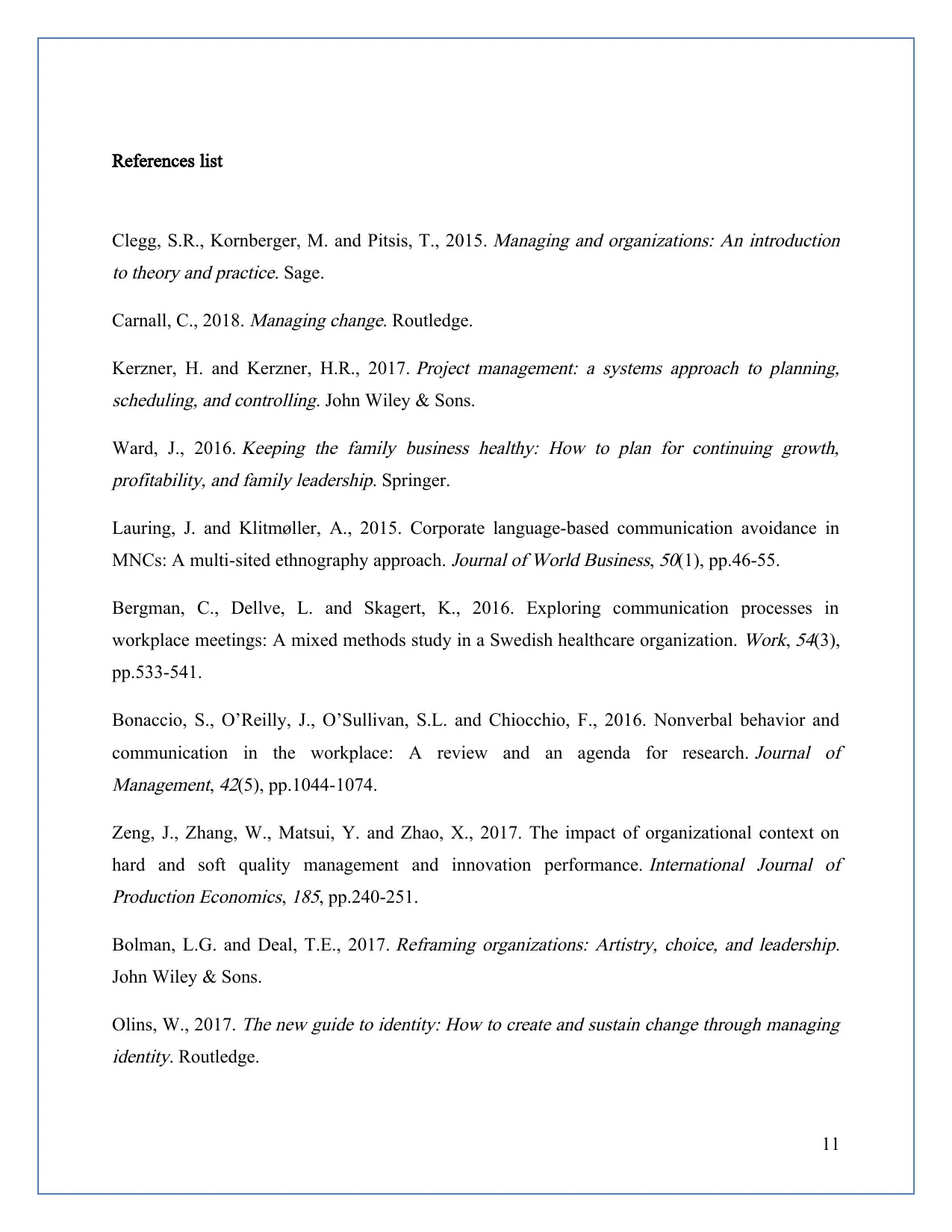
References list
Clegg, S.R., Kornberger, M. and Pitsis, T., 2015.
Managing and organizations: An introduction
to theory and practice. Sage.
Carnall, C., 2018.
Managing change. Routledge.
Kerzner, H. and Kerzner, H.R., 2017.
Project management: a systems approach to planning,
scheduling, and controlling. John Wiley & Sons.
Ward, J., 2016.
Keeping the family business healthy: How to plan for continuing growth,
profitability, and family leadership. Springer.
Lauring, J. and Klitmøller, A., 2015. Corporate language-based communication avoidance in
MNCs: A multi-sited ethnography approach.
Journal of World Business,
50(1), pp.46-55.
Bergman, C., Dellve, L. and Skagert, K., 2016. Exploring communication processes in
workplace meetings: A mixed methods study in a Swedish healthcare organization.
Work,
54(3),
pp.533-541.
Bonaccio, S., O’Reilly, J., O’Sullivan, S.L. and Chiocchio, F., 2016. Nonverbal behavior and
communication in the workplace: A review and an agenda for research.
Journal of
Management,
42(5), pp.1044-1074.
Zeng, J., Zhang, W., Matsui, Y. and Zhao, X., 2017. The impact of organizational context on
hard and soft quality management and innovation performance.
International Journal of
Production Economics,
185, pp.240-251.
Bolman, L.G. and Deal, T.E., 2017.
Reframing organizations: Artistry, choice, and leadership.
John Wiley & Sons.
Olins, W., 2017.
The new guide to identity: How to create and sustain change through managing
identity. Routledge.
11
Clegg, S.R., Kornberger, M. and Pitsis, T., 2015.
Managing and organizations: An introduction
to theory and practice. Sage.
Carnall, C., 2018.
Managing change. Routledge.
Kerzner, H. and Kerzner, H.R., 2017.
Project management: a systems approach to planning,
scheduling, and controlling. John Wiley & Sons.
Ward, J., 2016.
Keeping the family business healthy: How to plan for continuing growth,
profitability, and family leadership. Springer.
Lauring, J. and Klitmøller, A., 2015. Corporate language-based communication avoidance in
MNCs: A multi-sited ethnography approach.
Journal of World Business,
50(1), pp.46-55.
Bergman, C., Dellve, L. and Skagert, K., 2016. Exploring communication processes in
workplace meetings: A mixed methods study in a Swedish healthcare organization.
Work,
54(3),
pp.533-541.
Bonaccio, S., O’Reilly, J., O’Sullivan, S.L. and Chiocchio, F., 2016. Nonverbal behavior and
communication in the workplace: A review and an agenda for research.
Journal of
Management,
42(5), pp.1044-1074.
Zeng, J., Zhang, W., Matsui, Y. and Zhao, X., 2017. The impact of organizational context on
hard and soft quality management and innovation performance.
International Journal of
Production Economics,
185, pp.240-251.
Bolman, L.G. and Deal, T.E., 2017.
Reframing organizations: Artistry, choice, and leadership.
John Wiley & Sons.
Olins, W., 2017.
The new guide to identity: How to create and sustain change through managing
identity. Routledge.
11
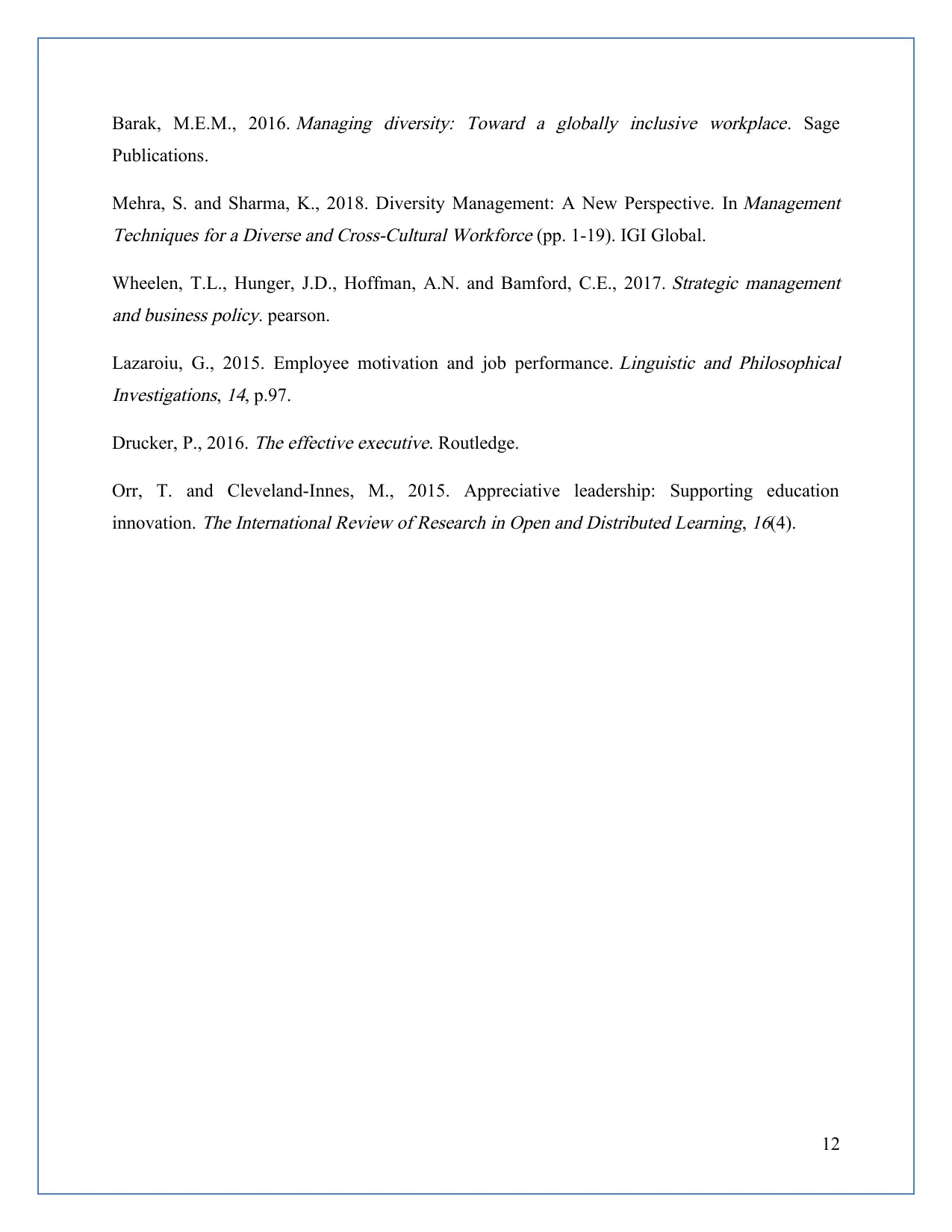
Barak, M.E.M., 2016.
Managing diversity: Toward a globally inclusive workplace. Sage
Publications.
Mehra, S. and Sharma, K., 2018. Diversity Management: A New Perspective. In
Management
Techniques for a Diverse and Cross-Cultural Workforce (pp. 1-19). IGI Global.
Wheelen, T.L., Hunger, J.D., Hoffman, A.N. and Bamford, C.E., 2017.
Strategic management
and business policy. pearson.
Lazaroiu, G., 2015. Employee motivation and job performance.
Linguistic and Philosophical
Investigations,
14, p.97.
Drucker, P., 2016.
The effective executive. Routledge.
Orr, T. and Cleveland-Innes, M., 2015. Appreciative leadership: Supporting education
innovation.
The International Review of Research in Open and Distributed Learning,
16(4).
12
Managing diversity: Toward a globally inclusive workplace. Sage
Publications.
Mehra, S. and Sharma, K., 2018. Diversity Management: A New Perspective. In
Management
Techniques for a Diverse and Cross-Cultural Workforce (pp. 1-19). IGI Global.
Wheelen, T.L., Hunger, J.D., Hoffman, A.N. and Bamford, C.E., 2017.
Strategic management
and business policy. pearson.
Lazaroiu, G., 2015. Employee motivation and job performance.
Linguistic and Philosophical
Investigations,
14, p.97.
Drucker, P., 2016.
The effective executive. Routledge.
Orr, T. and Cleveland-Innes, M., 2015. Appreciative leadership: Supporting education
innovation.
The International Review of Research in Open and Distributed Learning,
16(4).
12
⊘ This is a preview!⊘
Do you want full access?
Subscribe today to unlock all pages.

Trusted by 1+ million students worldwide
1 out of 12
Related Documents
Your All-in-One AI-Powered Toolkit for Academic Success.
+13062052269
info@desklib.com
Available 24*7 on WhatsApp / Email
![[object Object]](/_next/static/media/star-bottom.7253800d.svg)
Unlock your academic potential
Copyright © 2020–2025 A2Z Services. All Rights Reserved. Developed and managed by ZUCOL.





